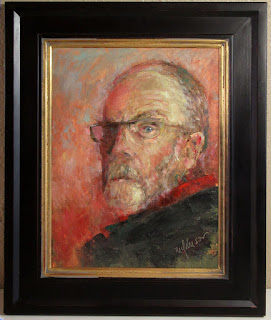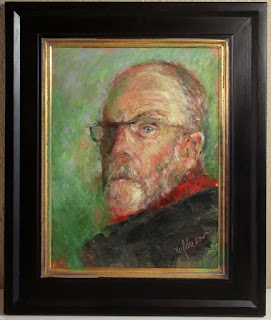 |
| Mr Hyde 16x12 Oil - NFS |
In a previous post, I wrote about a self-portrait I've been working on. At the time, the "first draft" of the self-portrait was complete; I'd spent about an hour in the studio, channeling Lucien Freud and, perhaps, Van Gogh. I was looking to achieve an intuitive but accurate representation in a short time. Liking the result, I posted it on Facebook and Instagram.
Well, turning a self-portrait into a group effort is always risky, as you never know what the responses will be—especially if you like what you've done and think the work is complete. Predictably, most responses (from close friends, family and fans) were favorable, but a few included suggestions. The most important suggestion, I thought, had to do with background color. The original background was a fiery red, and the red collar of my shirt got lost in it. What if, it was suggested, I remove the red background? The red collar would then "sing."
I wasn't sure if I wanted the red collar to "sing," but the suggestion planted the idea of playing with background color. So, I digitally changed the color to first green and then a bluish green and took a poll. First, here are the three images:
and here is the result of the poll:
Blue led with 47%, followed by red with 36%, and trailed by green, at 17%.
I was a little surprised that green didn't get a larger slice of the pie. Green tends to enhance the warmth of the face as well as that red collar. ("Now it really 'sings'!") And as much as some viewers didn't like the red—saying it made my expression feel even angrier—nearly as many people voted for red as for blue.
I also asked respondents to comment on their choices. These comments were interesting, too. Here are a few of them:
The Argument for Blue
- The contrast of cool and warm is more pleasing with the blue background.
- Blue...or red if you are after a very disturbing image. But I prefer the more peaceful bluish background.
- Although I do like the red one, the bluish background allows the red highlights to stand out in a very nice way. The red one makes me feel like you are standing near the Gates of Hades.
- They all create different moods, and they are all effective in their own way. So it depends on what kind of mood YOU want to create. I chose blue because the other two are too intense for my taste.
- Brings balance to the whole.
- The blue is cool enough to drop more into the background than the green and it picks up the colour in your eye. I was really okay with the red, too, but when you started to talk about the nice pop of red at your collar, I realized the sense in that.
- The intensity of the expression is exaggerated by the overall heat of the red background. I like the blue-green better.
- The red and green are to harsh (severe). They both compete with the portrait. The blue is more neutral, more sedate and doesn't compete with the portrait.
- The blue reads as neutral and calms the angry, intense red.
The Argument for Green
- The red is harsh and the scarf looks better with the green or blue background.
- More on the complementary side than red.
The Argument for Red
- Green makes you look sickly; red makes you look wise!
- Red is more unique and suits the warmth in your personality.
- The original red has a fabulous intensity. I always believe in creative 'gut reactions.' The original was painted that for a reason. The subconscious sees it as a more cohesive whole and focuses on the subject rather than the background.
- Red best suits the "aggressive" look of the face.
- The red is much more graphic and exciting. Yes, more grumpy, but more powerful.
- Red is an "energy" color..and a "passionate" color.
- The red seems to better suit the nature of the picture, and I like how it emphasizes the red collar/scarf.
The Argument for Something Else
(Yes, there's always someone who wants a choice outside the ones offered.)
- If you are questioning either red or green, why not mix them to create a neutral that picks up both in the portrait? Better harmony, and a bit more highlight/shadow would have your likeness leap off the canvas.
I actually began to modify the background in the portrait before I got so many votes and began to read the comments. As much as a fiery red background seemed appropriate at the time—I'd started with a burnt sienna background to give the canvas some initial life and warmth—it felt a little too much as I sat looking at it with a cup of tea during a relaxed moment. Green, I decided would make it too jazzy and, as someone else pointed out, invoked Van Gogh in a heavy-handed way. I decided to try blue. Blue calms, and I felt that's what the thing needed.
So, that one-hour self-portrait ended up having another few hours added to it in the way of background changes and tweaks. I initially started with a light blue scumble, but it gave the sense of floating through the sky. I darkened it, greyed it, and finally ended up with something that seemed to give the overall painting more weight. I also adjusted the contours of the head, getting it closer to the actual thing. (Yes, I had to pull out my antique 50-pound wall mirror a few more times.) I tweaked the facial hair, losing the lower lip and then regaining the lower lip. That "mystery eye," as someone called it—my right eye—needed more definition despite being in the shadows, so I played with that some until it read right. (Oh, and I ended up darkening that red collar. Too much "sing.")
The result of all this is the painting at the top of the post.
Am I as satisfied with the portrait as I was after that initial single hour of inspired bravura? I do like it, but it's going to sit on the easel for awhile longer. It is said:
A work of art is never finished, only abandoned.
and I think this is more true of a self-portrait than of any other type of painting.
 |
| Mr Hyde (framed) 16x12 Oil - NFS |
































